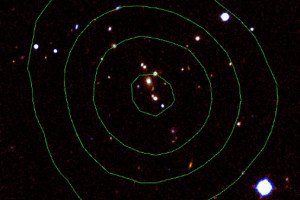Heavyweight Galaxies Puzzle Astronomers
2nd April 2009

A research team that includes an astronomer from The University of Manchester's Jodrell Bank Centre for Astrophysics has discovered large galaxies some two thirds of the way back in time to the big bang. This surprising find casts doubt on theories of how the biggest galaxies form.
The conventional view is that the heaviest galaxies in the universe started out very small and light and have gained most of their weight relatively recently by cannibalising other galaxies that came too close.
However, these new findings, published in Nature on 2nd April 2009, suggest that rather than being svelte, some galaxies in the distant past weighed just as much as the monsters we see in the universe today.
The discovery was made using one of the largest optical telescopes in the World, called Subaru (named after the Japanese word for the Pleiades star cluster), located on the Island of Hawaii and owned by the National Observatory of Japan.
Analysing the light from these remote galaxies, an international team of astronomers including Dr Scott Kay from the Jodrell Bank Centre for Astrophysics, has effectively weighed them and found that despite feeding on a constant diet of small galaxies, the heaviest galaxies have not increased their weight over the last nine billion years. In a universe whose age is 13.7 billion years old, these results spark a debate as to how these galaxies put on so much weight in the first few billion years after the big bang.
Professor Chris Collins of Liverpool John Moores University and leader of the international team of astrophysicists who made the breakthrough said:
"Current predictions using simulations run on super computers suggest that at such a young age these galaxies should be only 20% of their final weight, so to find galaxies so large suggests that galaxy formation is a much more rapid process than we previously thought and perhaps the theories are missing some important physics."
One possibility being considered is that the galaxies formed by the collapse of an already massive cloud at the dawn of the universe.
Notes for editors
This work was carried out with funding from the Science and Technology Facilities Council (STFC) which also funds the UK subscription to ESA (European Space Agency).
Subaru is operated by the National Astronomical Observatory of Japan and XMM-Newton is an ESA science mission funded by contributions to ESA members and from NASA.
The XMM X-ray Cluster Survey team consisted of:
- C Collins and J Stott (Liverpool John Moores University)
- M Hilton (KwaZulu-Natal, SA)
- S Kay (The University of Manchester)
- A Stanford (University of California, Davis)
- M Davidson (University of Edinburgh)
- M Hosmer (university of Sussex)
- B Hoyle (University of Portsmouth)
- A Liddle (University of Sussex)
- E Lloyd-Davies (University od Sussex)
- R Mann (University of Edinburgh)
- N Mehrtens (University of Sussex)
- C Miller (CTIO, USA)
- R Nichol (University of Portsmouth)
- A Romer (University of Sussex)
- Martin Sahlen (University of Sussex)
- P Viana (Universiadade do Porto, Portugal)
- M West (ESO, Chile)


